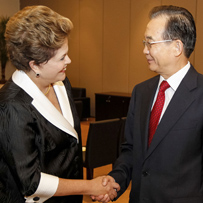You've successfully copied this link.
Best friends forever
By Juwai, 30 June 2012
Brazil and China announce a slew of new trade and finance deals. Week in China reports.

Shake on it: Brazil's president Dilma Rousseff meets Chinese premier Wen Jiabao in Rio
June 29, 2012 -- Remember the vuvuzela? Few will forget the ear-piercing sound of that Chinese-made plastic trumpet, which fans blew at the soccer World Cup in South Africa two years ago. What might China’s manufacturers be dreaming up for the next World Cup in Brazil (where the final is scheduled for Rio de Janeiro in two year’s time)? Indeed two years after that, there’ll be more merchandising opportunities as Rio hosts another sporting extravaganza, the 2016 Olympics. Perhaps that’s why the Economic Observer was reporting in April that Brazilians made up the largest contingent of buyers at this year’s Canton Fair – the bi-annual event where Made in China wares are showcased for foreign buyers. Those Brazilian customers are evidence of a growing interdependence between the two nations. That was signalled too by an announcement last week that China and Brazil have agreed a new, 10-year cooperation plan. The spin being applied by both parties was that this “strategic partnership†would be crucial in shaping Sino-Brazilian ties. But how close is the relationship today? What was agreed? The headline news from Rio was currency related. Specifically that China had agreed with Brazil to set up a $29 billion local currency swap deal. Under the new arrangement, Brazil has the option to access Rmb190 billion ($29.8 billion) in funds from the Chinese central bank, while the Chinese can draw down R$60 billion from the equivalent institution in Brazil. The hope is that both countries will be better protected in the event of the kind of credit panic triggered by the financial crisis of 2008, when access to the US dollar virtually seized up. Both countries will want to keep the commercial channels fully financed. Trade between the two has risen 17-fold over the last decade – indeed, China overtook the US in 2009 as Brazil’s leading trade partner. Beyond commerce, both countries share a desire to take up a more active role on the international stage. Policymakers from Brasilia and Beijing are pushing for a stronger say in multilateral institutions like the IMF and both governments are vocal on environmental issues, insisting that they cannot be expected to bear the same obligations as wealthier countries. Indeed a key reason Premier Wen Jiabao was in Rio was to attend an international environmental summit. Xinhua reckoned the two nations stood side-by-side in the negotiations. It cited comments by Andre Correa do Lago, Brazil’s chief negotiator to the summit that the two were now negotiating with a sense that they have the momentum on their side. “Rio92 happened when major advanced countries believed they had defined what the best way to develop was,†do Lago suggested. “But this conference takes place in a moment when developed countries are undergoing a great crisis, and developing countries like Brazil and China become much more important.†Sections of the Chinese media made a similar point, portraying China’s new influence in Latin America as a contrast to declining American sway in the region. An opinion piece in the China Daily on Monday opted to focus again on commercial ties, highlighting China’s status as the biggest trade partner not just for Brazil but for Argentina, Peru and Chile too. The suggestion was clear: that it is only a matter of time before the US is overtaken on a continent-wide basis, as China becomes an inescapable influence on the region. The piece even quoted Luis Miguel Castilla, Peru’s finance minister, for dramatic effect: “The truth is I light a candle every day and pray that China’s growth doesn’t fail.†But there must be differences too? Both Beijing and Brasilia face the challenge of slowing economies, with Chinese growth falling to 8.1% in the first quarter this year. Brazil did much worse, hardly growing at all. The consensus seems to be that Brazilian growth will stumble to about 2% for the year. Ruchir Sharma, author of Breakout Nations: In Pursuit of the Next Economic Miracles, compared the economies of the two countries in an article in Foreign Affairs this month. For Sharma, the tale is one of divergent development models, with China focusing on investment (at nearly 50% of GDP last year) while Brazil opts to spend on social welfare (at about 40% of it own GDP in 2010). Sharma takes spending on infrastructure as an example of how China has boosted its export economy, pouring capital into roads, ports and bridges. By contrast, Brazil has skimped on its infrastructure bill (at 2% of GDP, or about a fifth of China’s percentage spend), spending instead on free health care and a generous minimum wage. “That is largely why for the last three decades, China has grown four times as fast as Brazil,†Sharma concludes. The analysis has roused others to respond on Brazil’s behalf, noting that it outperforms China on criteria like per capita income, despite the many years of slower growth. Put simply, Brazilians are much richer than the Chinese. Even the poorest Brazilians have seen their incomes grow faster than their peers in China, where glaring income inequality is becoming a huge social issue. Here the suggestion is that Brazil’s more distributive economic model could be better positioned as “middle-income†status beckons. Certainly, China is looking to invest more in health and social security itself, in part to encourage its own citizens to save less and spend more. What about tensions over trade between the two? The trading relationship is a fairly lopsided one. China is Brazil’s leading trade partner but Brazil doesn’t even feature in China’s top 10 in commercial terms. There is also a clearly defined pattern of trade in which natural resources move from Brazil eastwards, and manufactured and industrial goods pass in the other direction. Yes, Brazil enjoys a trade surplus with China but only because of the flow of a small group of commodities like iron ore, soya beans and oil. The reliance on revenues from natural resources has been growing too – to nearly 84% of Brazil’s exports to China in 2010, up from 68% ten years before. Of course, this can play poorly to Latin American sensitivities, following a history in which its mineral and agricultural resources were shipped overseas to places like Europe, with foreign manufactured goods arriving in return. The threat then was that the continent’s economies would de-industrialise, and some Brazilian manufacturers have been warning of a similar danger today. Chinese exports to Brazil have grown fastest in machinery and electrical equipment, base metals, textiles, footwear and chemicals. But Brazilian producers have also been losing out in their exports to the US and Europe, as well as the markets of their Latin American neighbours. A report from the Brookings Institution last year detailed the impact in Argentina, where China’s share of total imports had more than doubled to 12.5% in the eight years to 2010. Brazil was still ahead but its own share had grown at a much slower pace. And in sectors like home appliances, the Chinese had surpassed the Brazilians as Argentina’s main suppliers. Another grievance is the renminbi’s exchange rate against the real, although Brazilian officials have preferred to broach the issue privately, rather than make a more public challenge. But coupled to local complaints that Brazilian companies aren’t getting the same chance to sell to Chinese consumers, the competitive tension has pushed the Rousseff administration to act. A more protectionist tinge has been applied to trade and industrial policy, applying new tariffs and setting minimum thresholds for local content in key industries. In September last year, after a surge in imports of Chinese cars, tariffs were increased by 30% for vehicles sold in Brazil with less than 65% local content. Similar regulations have been introduced requiring local content in the oil and mining sectors, as Brasilia tries to encourage local industries to supply the appropriate goods and services. Any attempt from the Chinese to smooth ties? There is some awareness of Brazilian concerns, hence the fanfare given to an agreement last week in which aircraft manufacturer Embraer announced production of Legacy business jets in Harbin, in a venture with Aviation Industry Corporation of China (AVIC). “Today’s announcement marks another milestone in the history of Embraer’s long term commitment to China and of Brazil-Sino bilateral relations,†celebrated Frederico Fleury Curado, Embraer’s president and CEO. “This new phase of AVIC-Embraer partnership corroborates what has been referred to by state leaders of both countries as ‘a model of South-South cooperation’.†China’s ICBC Financial Leasing – the aircraft leasing arm of ICBC, a leading state-owned bank – also committed to buying five of the business jets (they cost about $30 million each) with an option to purchase five more. That sounds like a positive step for Sino-Brazilian manufacturing relations, although the news also needs a little context. Embraer is not new to China, having first arrived in Harbin 12 years ago to make 50-seat regional jets. Production was then scaled back after disappointing sales, and Embraer tried to switch to assembly of its larger E190 jets. But it was forced to scrap the plan when local regulators turned down the idea, reputedly on concerns that the E190 would provide direct competition for the ARJ21, a similarly sized aircraft being made by the Commercial Aircraft Corporation of China (or Comac, a state-owned aerospace favourite). Embraer’s experience serves as a reminder that domestic loyalties often trump ties with a foreign partner and WiC readers will be familiar with another Brazilian firm experiencing something similar in recent months. Vale, the world’s second largest iron ore miner by volume, sells about 40% of its annual output to Chinese buyers. But as WiC has chronicled since October last year, Vale’s attempts to deliver its ore from a fleet of huge new vessels have been blocked by the Chinese authorities on safety and logistical grounds. Certainly, the 400,000 tonne vessels present a handling challenge to Chinese ports. Nor does it help that one of the new Valemax ships ran aground while loading in Brazil or that another experienced a ballast tank leak. But the suspicion is that Chinese shipowners have been pushing for the ban on fears that shipping between the two countries would be dominated by the new fleet. As a result Vale is being forced to use a transshipment hub in the Philippines, where the ore is moved onto smaller vessels bound for Chinese ports. In retaliation, it is said to be excluding Chinese ships from tendering for these voyages. And how is the trade mood likely to develop? Faced by a weak outlook in the US, and an even weaker one in the Eurozone, companies in Brazil and China will be hoping that consumer demand in each other’s markets can take up some of the slack. Of course, this comes at a time when the economies of both countries are slowing. For Brazil, the impact has been more immediately felt and in Sharma’s bleaker worldview, this looks set to continue. His premise is that the days in which Brazil secured 4% annual growth on the back of Chinese demand for its natural resources are at an end. Without further reform, the Brazilian economy looks set to lose further steam. That raises other questions about whether a wider slowdown puts more onus on the two sides to deepen ties further. Or the alternative: that tougher economic times see a more fractious mood develop, as the two countries compete for growth opportunities. One hope is that cross-border investment could lead to a more collaborative effort, taking the edge off some of the trading tension. Chinese investment in Brazil has ramped up significantly, from not much more than $500 million in 2009 to billions of dollars of capital inflow over each of the last three year (exact figures are difficult to pin down, as much of the investment is made through tax havens elsewhere). Again, natural resources deals were the first focus, particularly oil. State giant Sinopec bought a $7.1 billion 40% stake in Repsol Brazil in October two years ago and Sinochem purchased a similar percentage of the offshore Peregrino field from Norway’s Statoil for $3.1 billion the same year. In March this year, Sinopec was back in Brazil, this time to acquire 30% of Petrogal Brasil for $5.2 billion. The Chinese have more than oil on the shopping list. Electricity provider State Grid has also been on a spending spree, with a second major investment in March this year, after bidding almost $1 billion for seven power transmission lines formerly owned by a Spanish firm. It spent a similar amount two years ago on a 30-year licence to operate more than 3,000 kilometres of electricity transmission lines in Brazil’s largest cities. There have been investments in areas like iron ore mining and manufacturing locally too, where Chery, the automaker, is a pioneer. But again, there is an imbalance in the relationship, with the Brazil-China Business Council reporting at the end of last year that just 57 Brazilian firms had China investments by the end of 2011. That constituted less than 1% of Brazil’s total foreign direct investment.

